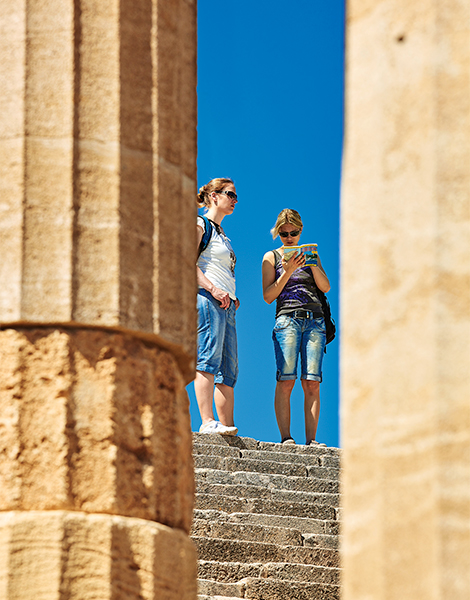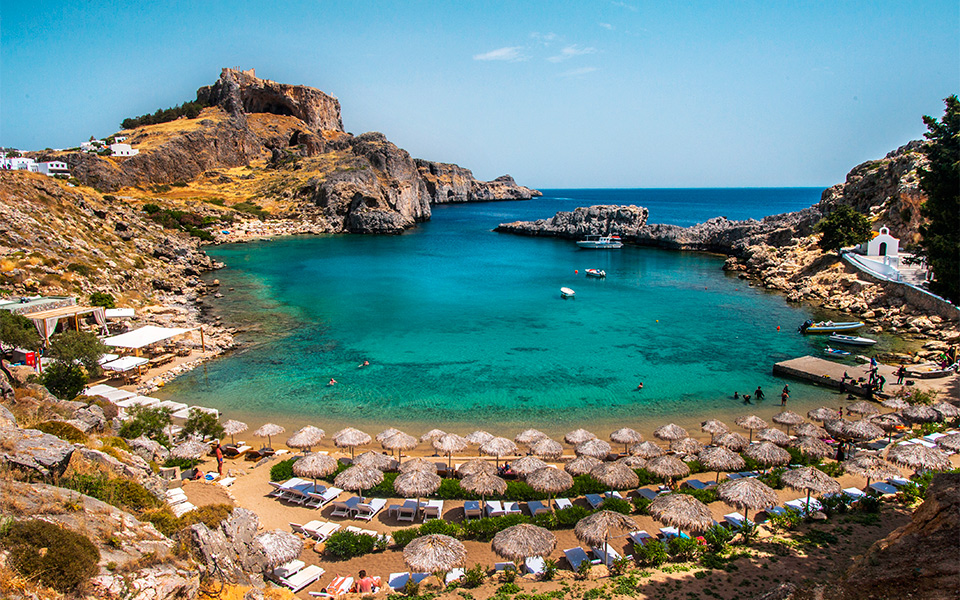Τhe “Christina,” the private yacht of the late Aristotle Onassis, lying at anchor in the sea below the rock of the acropolis; David Gilmour strumming his guitar in a pebbled courtyard; Brigitte Bardot strolling among pure-white houses on a winding backstreet: these images could be black-and-white photos on the wall of the historic Mavrikos restaurant, an old favorite in Lindos since 1912, but they’re not – because, “None of us thought to take photographs. We just took such scenes as part of ordinary life here,” explains chef and owner Dimitris Mavrikos.

© Perikles Merakos
Lindos was worshipped by the international jet set as early as the 1950s. It was then what Mykonos is today. Locals watched as, in just a few years, their village was transformed into a dazzling destination known around the world. “Onassis, Niarchos, Kennedy – they all passed through here. The FIAT tycoon Giovanni Agnelli had his own table at the restaurant. I remember him with his flowered swim trunks and Timberland shoes – which then were like gold for us – asking my father every morning what he was cooking that day.
Every summer, we were brimming with VIPs: from well-to-do Europeans to Hollywood stars. At first, we gawked at them, awestruck, but after a while we got used to them. It seemed very natural to see Sophia Loren passing by, or Yul Brynner, or Barbra Streisand. I’ll never forget the first time Pink Floyd came into the restaurant. The waiter didn’t recognize them and told me he wouldn’t serve those scruffy characters,” recalls the chef.
“The strange thing,” Mavrikos continues, “was that they didn’t go around the rest of the island, except for the occasional stroll around the Old Town. They were all especially interested in Lindos.”
It’s not difficult to understand why. Its architecture, evoking more the Cyclades than the Dodecanese, its three beaches with crystal clear waters and above all, literally as well as figuratively, the acropolis, on rocky cliffs 116m high, where traces of ancient Greeks, Byzantines and the Knights of St. John all coexist, are reasons enough to love Lindos.

© George Tsafos

© Clairy Moustafellou
The roots of the town’s cosmopolitanism are lost in the mists of time. The acropolis served as a center of worship, starting sometime in the Bronze Age, and the two adjacent natural harbors aided the ancient city in becoming a great naval power in the 6th c. BC under the tyrant Cleobulus. In the time of the Byzantines and Hospitallers, the acropolis was transformed into an impregnable castle, which, for a while, operated as a fortified settlement in its own right.
Through the centuries, the town of Lindos persisted in exactly the same protected spot where it is today, nestled into the hollow below the citadel – exhibiting even now much the same layout as it had in the past.
Today, Lindos is still one of the most popular destinations on Rhodes. A stream of humanity seems to flow perpetually through its central street. But not at midday. Then, the sun god Helios, worshipped on the island in antiquity, “prohibits” any movement. Along the town’s stone-paved lanes, even the cats forego their prowling. Merchants shelter within their shops; visitors foolhardy enough to be outside rest on stone benches or within shady passageways until the midday heat has passed. The sun’s blinding rays are reflected off whitewashed houses and little breeze penetrates the labyrinthine interior of Lindos – a village surrounded by barren mountains – where temperatures can reach 50 degrees Celsius.

© Clairy Moustafellou
This is why traditional Lindian dwellings, known as “kamarika,” essentially represent prototypical bioclimatic architecture. Constructed of straw, sand and lime, their walls reach thicknesses of 50cm. Externally, the walls are given uneven surfaces to create shade and drive away the heat. They also have skylights to allow air to circulate, a large interior arch and pebble-mosaic floors, called “hochlakia.”
In the old days, the village wasn’t white with limewash as it is today; instead it was various shades of ocher. “Most homes underwent several interventions in the 1980s and 1990s, however others remain in their original state,” says the architect of the Ephorate of Antiquities of the Dodecanese, Maria-Christina Georgali.
In the 16th century, after the departure of the Knights, shipping flourished again in Lindos. The following century saw the construction of the famous Lindian sea captains’ houses, which combine details from earlier traditional dwellings with the medieval architecture of noble Rhodians. “Today, about thirty of them remain. Most have been bought by Europeans. They are maintained in a very good state and many have all their original furnishings, as well as sundry items brought back by the captains from their journeys around the Mediterranean,” says archaeologist Charistoula Giakoumaki.

© Clairy Moustafellou

© Clairy Moustafellou
Behind the high limestone walls and monumental gateways, there are pebble-mosaic floors in various patterns, both in the courtyards and the rooms; arched doorways with relief decorations bearing Byzantine, medieval and Ottoman elements; wide pointed arches; painted ceilings; and elevated wooden platforms (soufas) on which the bed was placed. The most impressive features are perhaps the carved doorways and the captain’s “towers,” special rooms located above the doorways, which locals say let captains watch the sea.
The Papaconstantis and Markoulitsa Houses now belong to the Greek State but are not open for visitors. Several others, however, can be rented during the summer, offering a unique accommodation experience. They are managed by Sheila Markiou, who came to Lindos from the US in the 1970s and never left:
“I fell in love with the place at first sight. Even today, when I return from shopping in Rhodes Town and take the last turn on the road, I look towards Lindos and say ‘Ah! How beautiful it is…,’ even though I’ve lived here forty years.”

© Clairy Moustafellou
WALKING AROUND
Cars are prohibited in the village. So are motorcycles and scooters, although locals disregard this ban. Parking lots exist at both village entrances; from there, one continues on foot. The entire historic district of Lindos, which includes several neoclassical buildings, is a preserved area under the protection of the Greek Ministry of Culture. Locals lament that, even if they only want to patch a wall, they have to get a permit. However, to get a good look at the architecture being preserved, it’s necessary to get off the main street, which is so thickly packed with eateries and tourist shops (each displaying so many items for sale) that they virtually hide every inch of the whitewashed walls.
Indeed, on every side there are boutiques, jewelry shops, souvenir stalls featuring “ancient Greek” sandals and vendors hawking fresh juice. Even the Church of the Panagia, built in the 14th century to replace an older church and expanded by the Knights (the bell tower bears their heraldic emblem), usually boasts a crowd. Further along the same street, the “Traditional House” is open to the public and operates as a folk museum – with objects from daily life in the past centuries – and, of course, as a souvenir shop as well.
Near the southwest entrance to Lindos is the ancient theater. Harder to reach is the ancient necropolis, which locals call “Kampana,” although some funerary monuments can be seen above the main square. Outside the village, a grave known as the Tomb of Cleobulus overlooks the sea.

© Clairy Moustafellou
The main street leads to the path to the acropolis. The steep climb to the castle gateway takes about fifteen minutes. For those who’d rather not walk, donkeys are available, although the ride is as much a tourist attraction as it is a transportation option.
Along the ascending road, peddlers display woven tablecloths spread here and there on the ground. Visitors enter the castle through a gate built by the Knights of St. John (erected on top of a Byzantine fortification) and climb a lengthy staircase. Traces from every era reinforce just how strategic this place was through the ages: remnants of the Hellenistic-era sanctuary share the acropolis with Early Christian chapels and Byzantine churches.
The view in all directions is amazing. To the south is the beach of St. Paul, the second ancient natural port, which, from above, looks like a swimming pool. The Apostle Paul is said to have landed here, bringing Christianity. The beach is among the most popular on the island, and the forecourt of its small Byzantine church is a frequent wedding spot for foreigners. To the east, there are impressive cliffs; to the north, the beach of Megalos Yialos. For most people, however, it is enough to sit on the steps of the Hellenistic stoa, in the shade of the columns. The breeze that usually blows here offers a welcome respite from the heat.












